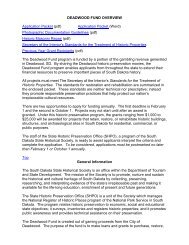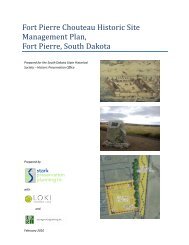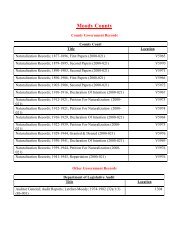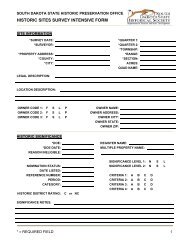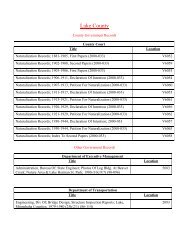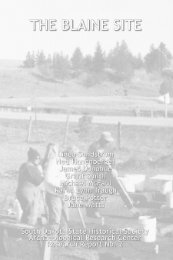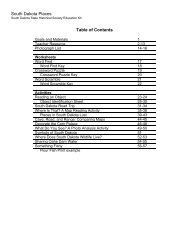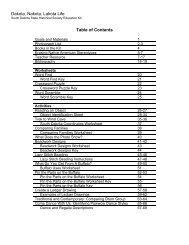A Geoarchaeological Overview of South Dakota and Preliminary
A Geoarchaeological Overview of South Dakota and Preliminary
A Geoarchaeological Overview of South Dakota and Preliminary
Create successful ePaper yourself
Turn your PDF publications into a flip-book with our unique Google optimized e-Paper software.
DRAFT DRAFT DRAFT<br />
correlate with the Oahe Formation are also recognized (Artz 1995), including the Leonard paleosol (Artz<br />
<strong>and</strong> Ahler 1989; Van Nest 1985).<br />
Donohue <strong>and</strong> Hannenberger (2001) note the identification <strong>of</strong> Oahe Formation sediments at sites in<br />
Dewey, Custer, Potter, Buffalo, Tripp, <strong>and</strong> Melette counties. It is present on terraces <strong>of</strong> the Missouri<br />
Trench (Coogan 1987) <strong>and</strong> in the White River badl<strong>and</strong>s (Kuehn 2003). Its presence is poorly known in<br />
the East River portions <strong>of</strong> both <strong>Dakota</strong>s.<br />
DeForest Formation<br />
The DeForest Formation is a stratigraphic sequence defined for Holocene valley alluvium in Iowa <strong>and</strong><br />
eastern Nebraska (Bettis 1990; Bettis <strong>and</strong> M<strong>and</strong>el 2000). Alluvial stratigraphy in southeastern <strong>South</strong><br />
<strong>Dakota</strong> in the James, Vermillion, <strong>and</strong> Big Sioux river drainages closely resembles <strong>and</strong> undoubtedly<br />
correlates with sediments <strong>of</strong> the DeForest Formation (Artz <strong>and</strong> Riley 2006; James Donohue <strong>and</strong> Michael<br />
Kolb, personal communication 2011). The DeForest Formation has several members. The Gunder,<br />
Roberts Creek, <strong>and</strong> Camp Creek members are early-middle Holocene, late Holocene, <strong>and</strong> historic in age,<br />
respectively, <strong>and</strong> are comprised <strong>of</strong> alluvial sediments. The Corrington Member is early-middle Holocene<br />
in age, <strong>and</strong> underlies the surface <strong>of</strong> alluvial fans. The Honey Creek Member, a late Holocene unit, has<br />
been defined in eastern Nebraska by Dillon <strong>and</strong> M<strong>and</strong>el (2005), but has not yet been widely traced in<br />
adjacent states. The DeForest Formation members are differentiated primarily by color, texture,<br />
sedimentary bedding, <strong>and</strong> soil horizonation (Bettis 1990).<br />
The northern extent <strong>of</strong> the DeForest Formation is not known but probably does not extend to the<br />
state’s northern border. The James River alluvial sequences described by Picha <strong>and</strong> Gregg (1985) in<br />
southeastern North <strong>Dakota</strong> are more complexly stratified than the usually homogenous DeForest<br />
Formation, <strong>and</strong> therefore represent a different, <strong>and</strong> as yet not formally named stratigraphic unit. Alluvial<br />
sediments in the Missouri Trench do not resemble the DeForest Formation, nor do those west <strong>of</strong> the<br />
river.<br />
Northwestern Plains Alluvial Sequences<br />
A number <strong>of</strong> alluvial terrace sequences have been defined for the northwestern Plains (Albanese <strong>and</strong><br />
Wilson 1974; Haynes 1968; Leopold <strong>and</strong> Miller 1954). Albanese (1998) extended these to western<br />
<strong>South</strong> <strong>Dakota</strong>, basing his discussion on a sequence <strong>of</strong> five units, A-E, originally defined by Haynes<br />
(1968) for a much larger area <strong>of</strong> the western United States. As summarized by Hajic (2008:9-10), Units<br />
A <strong>and</strong> B formed between about 14,000 <strong>and</strong> 8500 B.P., <strong>and</strong> contain many <strong>of</strong> the region’s known<br />
Paleoindian sites. Unit C was deposited between 7500 <strong>and</strong> 5500 BP, <strong>and</strong> is separated from Units A-B by<br />
an erosion surface that represents a ca. 1000 year gap in the sedimentary record, <strong>and</strong> in some areas, such<br />
as the Powder River Basin, is missing entirely. Unit D is primarily a colluvial unit that was deposited<br />
between 5000 <strong>and</strong> 1200 B.P., <strong>and</strong> <strong>of</strong>ten contains Middle <strong>and</strong> Late Plains Archaic sites. Unit E was<br />
deposited after 1000 B.P., following a period <strong>of</strong> regional stream entrenchment between 1200 <strong>and</strong> 1000<br />
B.P. Albanese (1998) suggests that this entrenchment resulted in the formation <strong>of</strong> three alluvial terraces,<br />
correlated with the Kaycee, Moorcr<strong>of</strong>t, <strong>and</strong> Lighting terraces defined by Leopold <strong>and</strong> Miller (1954).<br />
GEOLOGICAL PROCESSES<br />
Identifying <strong>and</strong> evaluating buried site potential requires an underst<strong>and</strong>ing <strong>of</strong> the geological processes<br />
that are at work in the l<strong>and</strong>scape. Prehistoric people focused on specific locations, <strong>and</strong> <strong>of</strong>ten specific<br />
l<strong>and</strong>forms in deciding where to live or carry out non-habitation tasks. Consequently, identifying <strong>and</strong><br />
evaluating buried sites requires an underst<strong>and</strong>ing <strong>of</strong> geological processes that work at a scale similar to<br />
that <strong>of</strong> an archaeological site or site cluster.<br />
18





